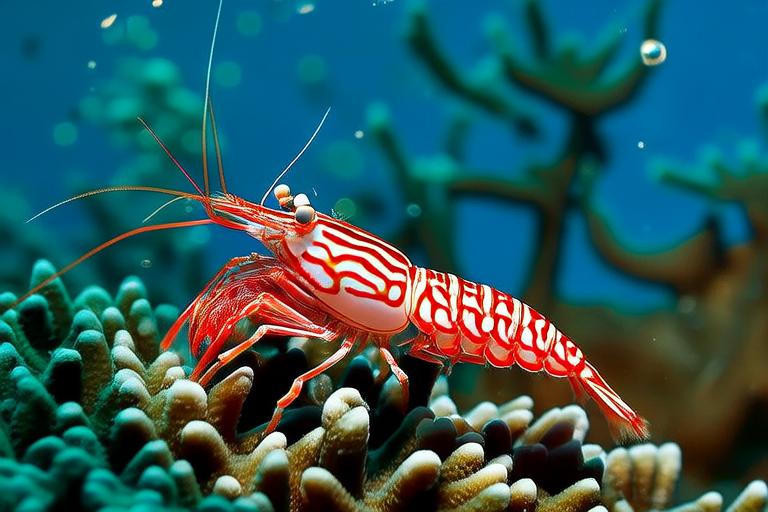Beginner’s Guide to Coral Shrimp
Welcome to your comprehensive guide to coral shrimp! This captivating creature is a favorite among marine enthusiasts and hobbyists alike. In this guide, we will explore the world of coral shrimp, from their role in marine ecosystems to the intricacies of keeping them as pets. Let’s dive into the fascinating world of these tiny aquatic wonders.
Introduction to Coral Shrimp
Coral shrimp, also known as cleaner shrimp, are small crustaceans that play a crucial role in marine ecosystems. They belong to the family Palaemonidae, which includes over 3,000 species. These shrimp are named after their habitat preference, as they often reside in and around coral reefs, where they provide essential cleaning services to larger marine animals. Their vibrant colors and unique behaviors make them popular additions to home aquariums.
Significance in Marine Ecosystems
In nature, coral shrimp act as ‘cleaners,’ removing parasites, dead tissue, and debris from the skin and gills of larger fish. This mutualistic relationship benefits both parties: the shrimp get a steady food source, and the fish enjoy a healthier body. This symbiotic interaction underscores the importance of biodiversity in maintaining healthy marine environments.
Different Species of Coral Shrimp
Beekeeping Cleaner Shrimp (Lysmata amboinensis)
The beekeeping cleaner shrimp, also called the scarlet cleaner shrimp, is one of the most recognizable species due to its bright red coloration. Native to the Indo-Pacific region, it thrives in coral reef environments. This shrimp is particularly popular in home aquariums because of its striking appearance and beneficial cleaning behavior.
Peppermint Shrimp (Lysmata wurdemanni)
Peppermint shrimp, native to the Western Atlantic, have a distinct striped pattern resembling peppermint candy. They are highly sought after for their ability to control populations of Aiptasia, a type of invasive anemone that can harm coral reefs. In captivity, they are valued for their algae-eating habits.
Banded Coral Shrimp (Stenopus hispidus)
The banded coral shrimp is another well-known species, characterized by its black-and-white-striped body. Found primarily in the Caribbean and Western Atlantic, it is known for its aggressive cleaning behavior and territorial nature. It can be challenging to keep in aquariums due to its predatory tendencies.
Natural Habitats
Coral shrimp prefer tropical and subtropical waters with abundant coral reefs. These environments provide shelter, food, and protection from predators. In the wild, they can be found in shallow waters near the shore, where they can easily access larger fish and other marine life for cleaning.
Behavioral Characteristics
Coral shrimp exhibit several interesting behaviors. They are typically nocturnal, becoming more active at night when they search for food and perform their cleaning duties. During the day, they usually hide in crevices or under rocks to avoid predators. When cleaning, they use their claws to remove parasites and dead tissue from the bodies of larger fish.
Keeping Coral Shrimp as Pets
Tank Setup Requirements
To maintain coral shrimp successfully, it is essential to set up an appropriate tank environment. A minimum tank size of 20 gallons is recommended for a small group of shrimp. The tank should include plenty of hiding spots, such as rock formations and live rock, which offer shelter and promote a natural environment. Live rock also provides a source of algae and microorganisms for the shrimp to feed on.
Water quality is critical for the health of coral shrimp. Maintain stable parameters with a pH between 8.1 and 8.4, a specific gravity of 1.023 to 1.025, and a temperature range of 75 to 82 degrees Fahrenheit. Regular water changes and proper filtration are necessary to ensure clean and healthy conditions.
Diet
In the wild, coral shrimp are omnivores, feeding on a variety of foods, including parasites, dead tissue, algae, and detritus. In captivity, you can provide them with a balanced diet of commercial shrimp pellets, algae wafers, and blanched vegetables like spinach or zucchini. Additionally, they benefit from occasional treats like frozen brine shrimp or mysis shrimp.
Common Health Issues
While coral shrimp are generally hardy, they can be susceptible to certain health problems if not cared for properly. Common issues include bacterial infections, parasitic infestations, and stress-related illnesses. Regular observation and prompt treatment of any signs of illness are crucial. Maintaining optimal water conditions and providing a varied diet can help prevent many health issues.
Tips for Beginners
- Research: Before purchasing coral shrimp, thoroughly research their needs and compatibility with other tank inhabitants.
- Acclimation: Gradually acclimate new shrimp to the tank environment to minimize stress and improve survival rates.
- Monitor: Regularly monitor water parameters and observe shrimp behavior to ensure they are thriving.
- Patience: Be patient while setting up the tank and introducing shrimp, as it may take time for them to adjust to their new surroundings.
Importance of Responsible Pet Ownership and Conservation Efforts
As with any pet, responsible ownership is key to ensuring the well-being of coral shrimp. Proper care and maintenance of the aquarium environment contribute to the longevity and health of these creatures. Additionally, supporting conservation efforts helps protect coral reefs and their inhabitants in the wild. By choosing sustainable practices and advocating for marine conservation, we can help preserve the delicate balance of our oceans.
Conservation efforts are vital to the survival of coral reefs and the countless species that depend on them. Supporting organizations dedicated to reef preservation and participating in citizen science projects can make a significant difference. Remember, every action counts, whether it’s reducing plastic waste, supporting eco-friendly products, or spreading awareness about the importance of marine conservation.
By following the guidelines outlined in this beginner’s guide, you can enjoy the beauty and wonder of coral shrimp while contributing positively to their conservation. Happy shrimp keeping!
